Page 57 of 82
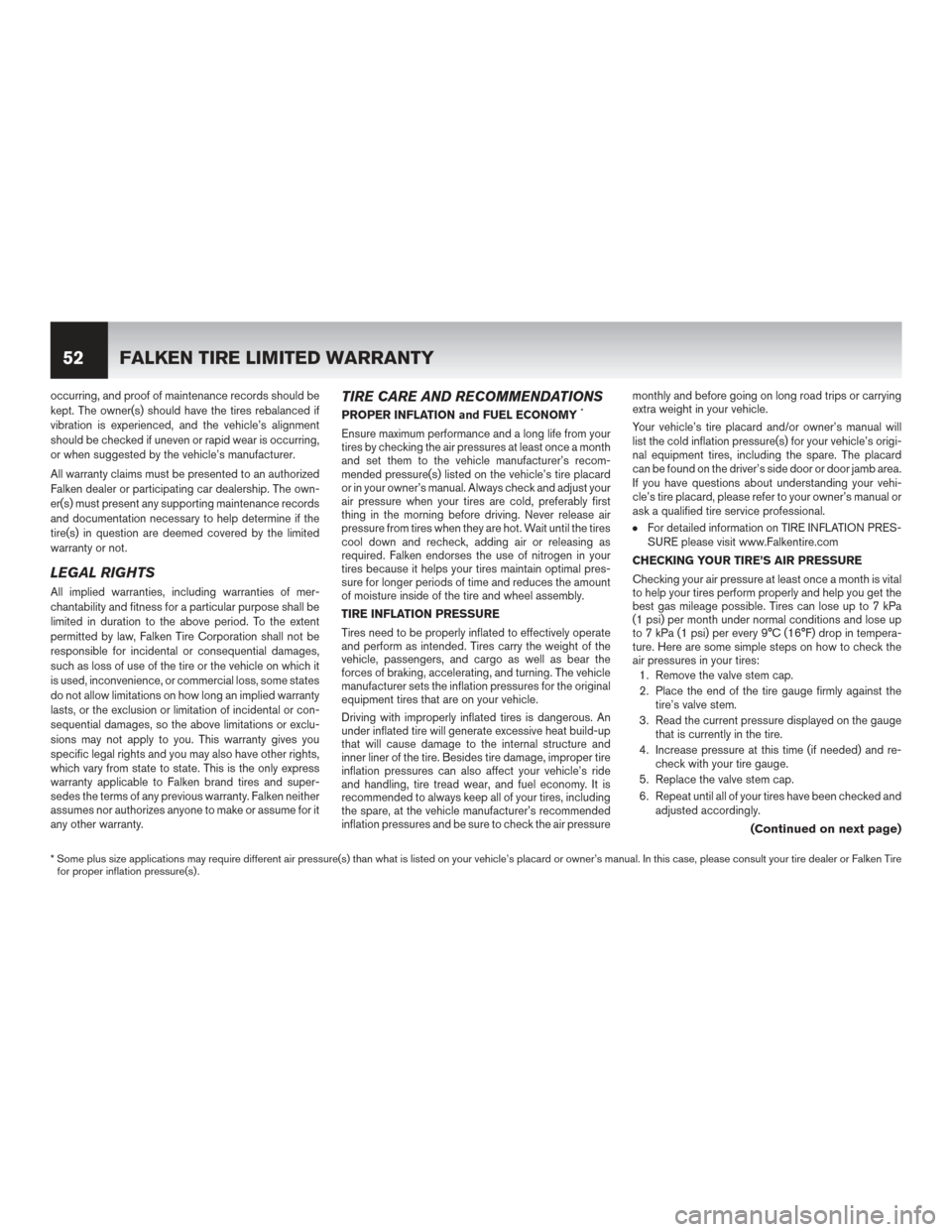
occurring, and proof of maintenance records should be
kept. The owner(s) should have the tires rebalanced if
vibration is experienced, and the vehicle’s alignment
should be checked if uneven or rapid wear is occurring,
or when suggested by the vehicle’s manufacturer.
All warranty claims must be presented to an authorized
Falken dealer or participating car dealership. The own-
er(s) must present any supporting maintenance records
and documentation necessary to help determine if the
tire(s) in question are deemed covered by the limited
warranty or not.
LEGAL RIGHTS
All implied warranties, including warranties of mer-
chantability and fitness for a particular purpose shall be
limited in duration to the above period. To the extent
permitted by law, Falken Tire Corporation shall not be
responsible for incidental or consequential damages,
such as loss of use of the tire or the vehicle on which it
is used, inconvenience, or commercial loss, some states
do not allow limitations on how long an implied warranty
lasts, or the exclusion or limitation of incidental or con-
sequential damages, so the above limitations or exclu-
sions may not apply to you. This warranty gives you
specific legal rights and you may also have other rights,
which vary from state to state. This is the only express
warranty applicable to Falken brand tires and super-
sedes the terms of any previous warranty. Falken neither
assumes nor authorizes anyone to make or assume for it
any other warranty.
TIRE CARE AND RECOMMENDATIONS
PROPER INFLATION and FUEL ECONOMY*
Ensure maximum performance and a long life from your
tires by checking the air pressures at least once a month
and set them to the vehicle manufacturer’s recom-
mended pressure(s) listed on the vehicle’s tire placard
or in your owner’s manual. Always check and adjust your
air pressure when your tires are cold, preferably first
thing in the morning before driving. Never release air
pressure from tires when they are hot. Wait until the tires
cool down and recheck, adding air or releasing as
required. Falken endorses the use of nitrogen in your
tires because it helps your tires maintain optimal pres-
sure for longer periods of time and reduces the amount
of moisture inside of the tire and wheel assembly.
TIRE INFLATION PRESSURE
Tires need to be properly inflated to effectively operate
and perform as intended. Tires carry the weight of the
vehicle, passengers, and cargo as well as bear the
forces of braking, accelerating, and turning. The vehicle
manufacturer sets the inflation pressures for the original
equipment tires that are on your vehicle.
Driving with improperly inflated tires is dangerous. An
under inflated tire will generate excessive heat build-up
that will cause damage to the internal structure and
inner liner of the tire. Besides tire damage, improper tire
inflation pressures can also affect your vehicle’s ride
and handling, tire tread wear, and fuel economy. It is
recommended to always keep all of your tires, including
the spare, at the vehicle manufacturer’s recommended
inflation pressures and be sure to check the air pressuremonthly and before going on long road trips or carrying
extra weight in your vehicle.
Your vehicle’s tire placard and/or owner’s manual will
list the cold inflation pressure(s) for your vehicle’s origi-
nal equipment tires, including the spare. The placard
can be found on the driver’s side door or door jamb area.
If you have questions about understanding your vehi-
cle’s tire placard, please refer to your owner’s manual or
ask a qualified tire service professional.
●For detailed information on TIRE INFLATION PRES-
SURE please visit www.Falkentire.com
CHECKING YOUR TIRE’S AIR PRESSURE
Checking your air pressure at least once a month is vital
to help your tires perform properly and help you get the
best gas mileage possible. Tires can lose up to 7 kPa
(1 psi) per month under normal conditions and lose up
to 7 kPa (1 psi) per every 9°C (16°F) drop in tempera-
ture. Here are some simple steps on how to check the
air pressures in your tires: 1. Remove the valve stem cap.
2. Place the end of the tire gauge firmly against the tire’s valve stem.
3. Read the current pressure displayed on the gauge that is currently in the tire.
4. Increase pressure at this time (if needed) and re- check with your tire gauge.
5. Replace the valve stem cap.
6. Repeat until all of your tires have been checked and adjusted accordingly.
(Continued on next page)
* Some plus size applications may require different air pressure(s) than what is listed on your vehicle’s placard or owner’s manual. In this case, please consult your tire dealer or Falken Tire
for proper inflation pressure(s) .
52 FALKEN TIRE LIMITED WARRANTY
Page 58 of 82
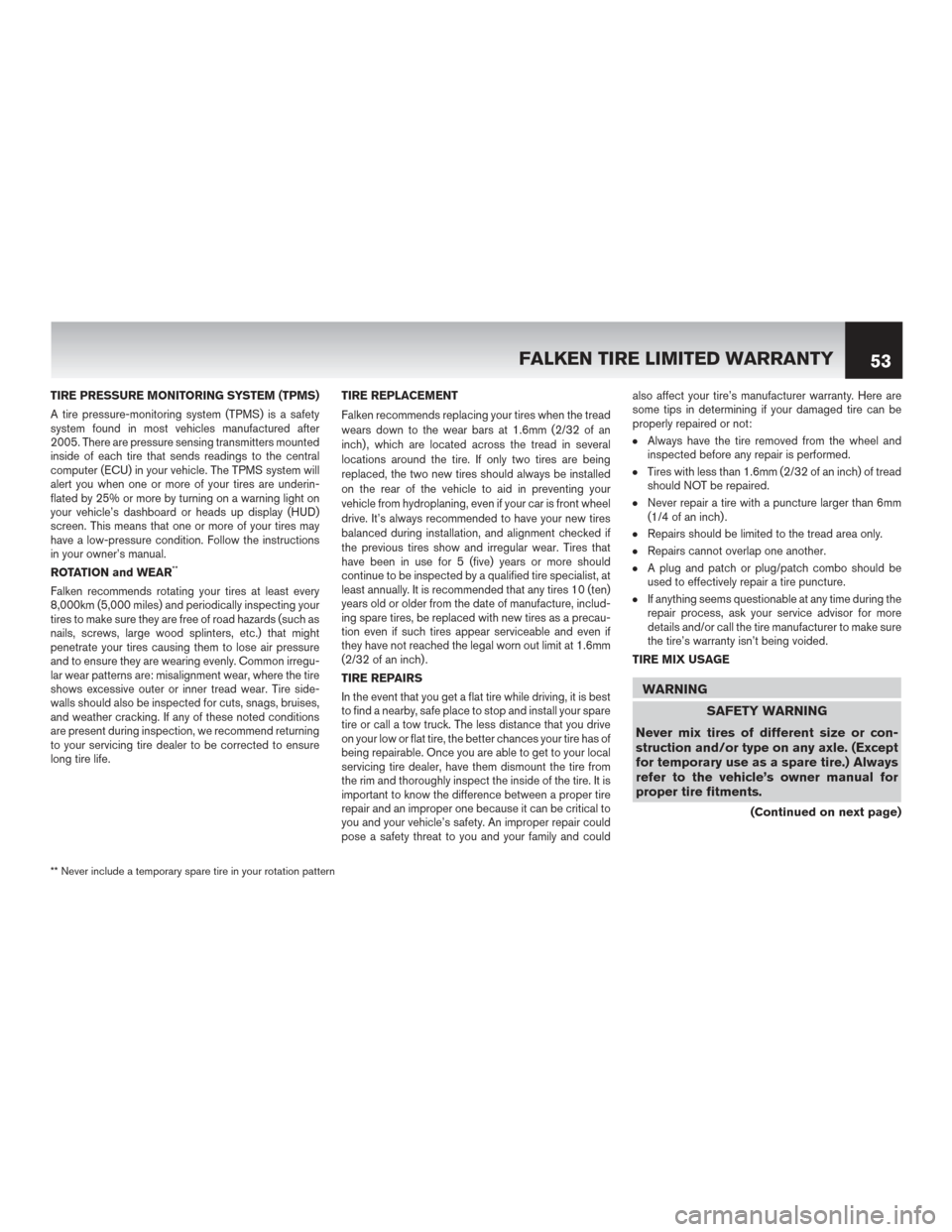
TIRE PRESSURE MONITORING SYSTEM (TPMS)
A tire pressure-monitoring system (TPMS) is a safety
system found in most vehicles manufactured after
2005. There are pressure sensing transmitters mounted
inside of each tire that sends readings to the central
computer (ECU) in your vehicle. The TPMS system will
alert you when one or more of your tires are underin-
flated by 25% or more by turning on a warning light on
your vehicle’s dashboard or heads up display (HUD)
screen. This means that one or more of your tires may
have a low-pressure condition. Follow the instructions
in your owner’s manual.
ROTATION and WEAR
**
Falken recommends rotating your tires at least every
8,000km (5,000 miles) and periodically inspecting your
tires to make sure they are free of road hazards (such as
nails, screws, large wood splinters, etc.) that might
penetrate your tires causing them to lose air pressure
and to ensure they are wearing evenly. Common irregu-
lar wear patterns are: misalignment wear, where the tire
shows excessive outer or inner tread wear. Tire side-
walls should also be inspected for cuts, snags, bruises,
and weather cracking. If any of these noted conditions
are present during inspection, we recommend returning
to your servicing tire dealer to be corrected to ensure
long tire life.TIRE REPLACEMENT
Falken recommends replacing your tires when the tread
wears down to the wear bars at 1.6mm (2/32 of an
inch) , which are located across the tread in several
locations around the tire. If only two tires are being
replaced, the two new tires should always be installed
on the rear of the vehicle to aid in preventing your
vehicle from hydroplaning, even if your car is front wheel
drive. It’s always recommended to have your new tires
balanced during installation, and alignment checked if
the previous tires show and irregular wear. Tires that
have been in use for 5 (five) years or more should
continue to be inspected by a qualified tire specialist, at
least annually. It is recommended that any tires 10 (ten)
years old or older from the date of manufacture, includ-
ing spare tires, be replaced with new tires as a precau-
tion even if such tires appear serviceable and even if
they have not reached the legal worn out limit at 1.6mm
(2/32 of an inch) .
TIRE REPAIRS
In the event that you get a flat tire while driving, it is best
to find a nearby, safe place to stop and install your spare
tire or call a tow truck. The less distance that you drive
on your low or flat tire, the better chances your tire has of
being repairable. Once you are able to get to your local
servicing tire dealer, have them dismount the tire from
the rim and thoroughly inspect the inside of the tire. It is
important to know the difference between a proper tire
repair and an improper one because it can be critical to
you and your vehicle’s safety. An improper repair could
pose a safety threat to you and your family and couldalso affect your tire’s manufacturer warranty. Here are
some tips in determining if your damaged tire can be
properly repaired or not:
●Always have the tire removed from the wheel and
inspected before any repair is performed.
●Tires with less than 1.6mm (2/32 of an inch) of tread
should NOT be repaired.
●Never repair a tire with a puncture larger than 6mm
(1/4 of an inch) .
●Repairs should be limited to the tread area only.
●Repairs cannot overlap one another.
●A plug and patch or plug/patch combo should be
used to effectively repair a tire puncture.
●If anything seems questionable at any time during the
repair process, ask your service advisor for more
details and/or call the tire manufacturer to make sure
the tire’s warranty isn’t being voided.
TIRE MIX USAGE
WARNING
SAFETY WARNING
Never mix tires of different size or con-
struction and/or type on any axle. (Except
for temporary use as a spare tire.) Always
refer to the vehicle’s owner manual for
proper tire fitments.
(Continued on next page)
** Never include a temporary spare tire in your rotation pattern
FALKEN TIRE LIMITED WARRANTY 53
Page 59 of 82
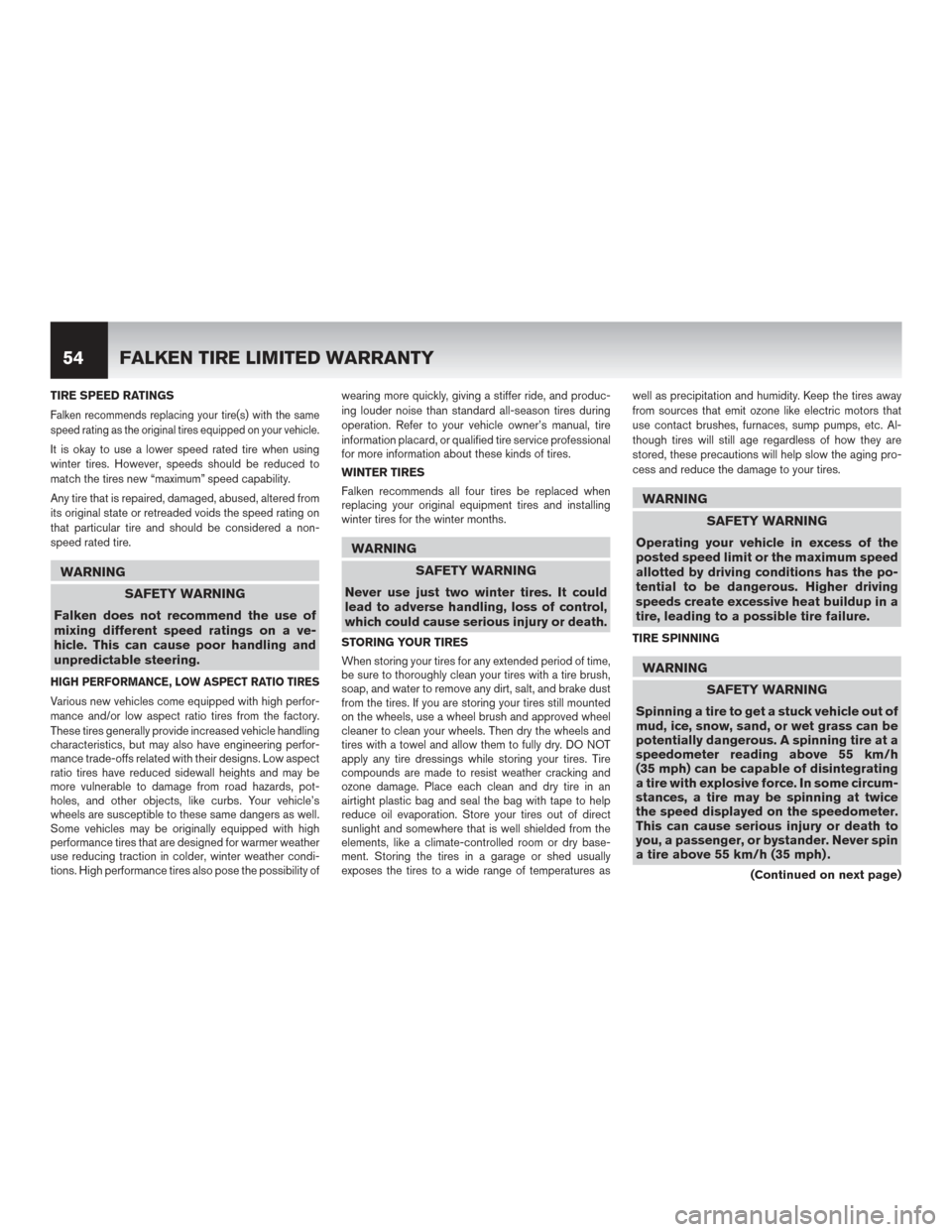
TIRE SPEED RATINGS
Falken recommends replacing your tire(s) with the same
speed rating as the original tires equipped on your vehicle.
It is okay to use a lower speed rated tire when using
winter tires. However, speeds should be reduced to
match the tires new “maximum” speed capability.
Any tire that is repaired, damaged, abused, altered from
its original state or retreaded voids the speed rating on
that particular tire and should be considered a non-
speed rated tire.
WARNINGSAFETY WARNING
Falken does not recommend the use of
mixing different speed ratings on a ve-
hicle. This can cause poor handling and
unpredictable steering.
HIGH PERFORMANCE, LOW ASPECT RATIO TIRES
Various new vehicles come equipped with high perfor-
mance and/or low aspect ratio tires from the factory.
These tires generally provide increased vehicle handling
characteristics, but may also have engineering perfor-
mance trade-offs related with their designs. Low aspect
ratio tires have reduced sidewall heights and may be
more vulnerable to damage from road hazards, pot-
holes, and other objects, like curbs. Your vehicle’s
wheels are susceptible to these same dangers as well.
Some vehicles may be originally equipped with high
performance tires that are designed for warmer weather
use reducing traction in colder, winter weather condi-
tions. High performance tires also pose the possibility of wearing more quickly, giving a stiffer ride, and produc-
ing louder noise than standard all-season tires during
operation. Refer to your vehicle owner’s manual, tire
information placard, or qualified tire service professional
for more information about these kinds of tires.
WINTER TIRES
Falken recommends all four tires be replaced when
replacing your original equipment tires and installing
winter tires for the winter months.
WARNING
SAFETY WARNING
Never use just two winter tires. It could
lead to adverse handling, loss of control,
which could cause serious injury or death.
STORING YOUR TIRES
When storing your tires for any extended period of time,
be sure to thoroughly clean your tires with a tire brush,
soap, and water to remove any dirt, salt, and brake dust
from the tires. If you are storing your tires still mounted
on the wheels, use a wheel brush and approved wheel
cleaner to clean your wheels. Then dry the wheels and
tires with a towel and allow them to fully dry. DO NOT
apply any tire dressings while storing your tires. Tire
compounds are made to resist weather cracking and
ozone damage. Place each clean and dry tire in an
airtight plastic bag and seal the bag with tape to help
reduce oil evaporation. Store your tires out of direct
sunlight and somewhere that is well shielded from the
elements, like a climate-controlled room or dry base-
ment. Storing the tires in a garage or shed usually
exposes the tires to a wide range of temperatures as well as precipitation and humidity. Keep the tires away
from sources that emit ozone like electric motors that
use contact brushes, furnaces, sump pumps, etc. Al-
though tires will still age regardless of how they are
stored, these precautions will help slow the aging pro-
cess and reduce the damage to your tires.
WARNING
SAFETY WARNING
Operating your vehicle in excess of the
posted speed limit or the maximum speed
allotted by driving conditions has the po-
tential to be dangerous. Higher driving
speeds create excessive heat buildup in a
tire, leading to a possible tire failure.
TIRE SPINNING
WARNING SAFETY WARNING
Spinning a tire to get a stuck vehicle out of
mud, ice, snow, sand, or wet grass can be
potentially dangerous. A spinning tire at a
speedometer reading above 55 km/h
(35 mph) can be capable of disintegrating
a tire with explosive force. In some circum-
stances, a tire may be spinning at twice
the speed displayed on the speedometer.
This can cause serious injury or death to
you, a passenger, or bystander. Never spin
a tire above 55 km/h (35 mph) .
(Continued on next page)
54 FALKEN TIRE LIMITED WARRANTY
Page 60 of 82
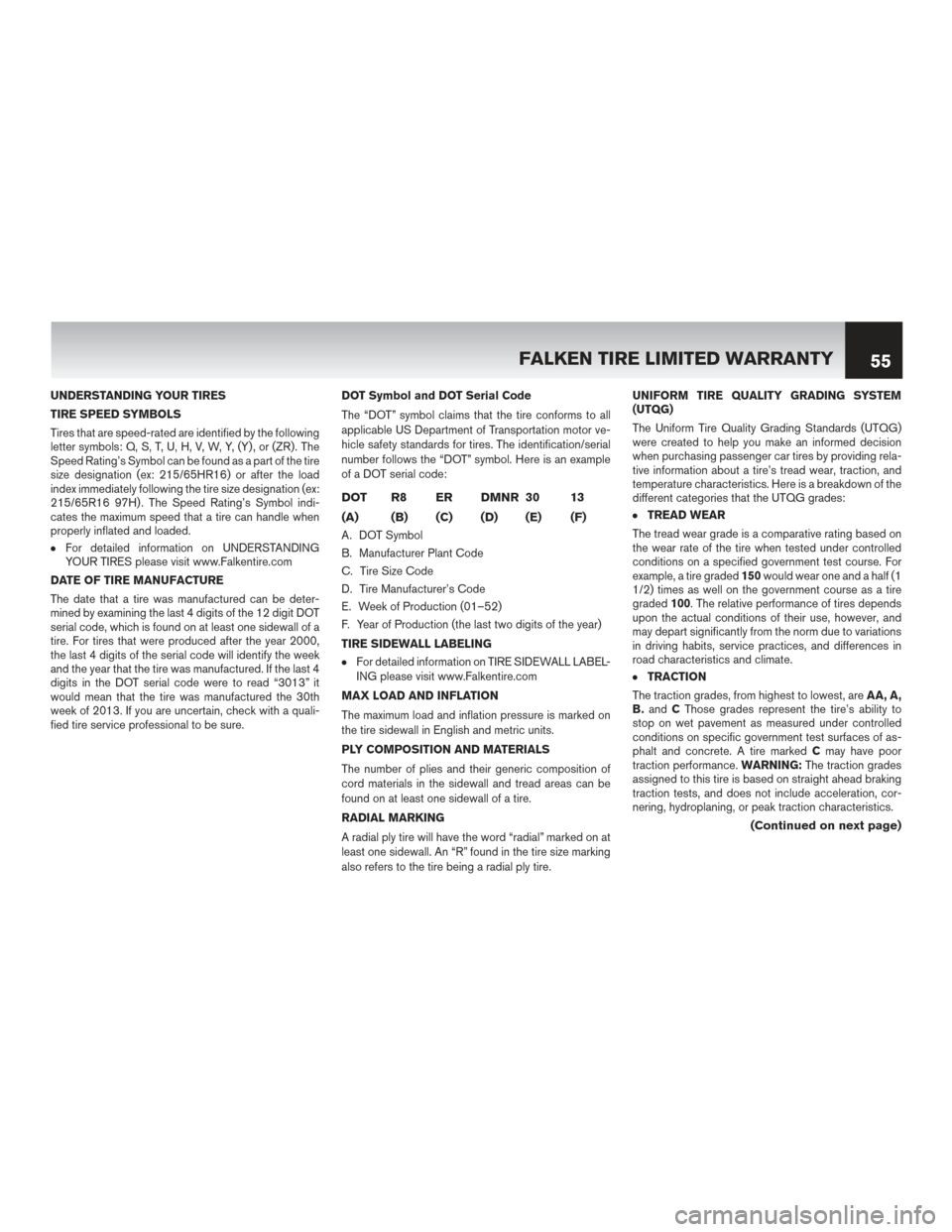
UNDERSTANDING YOUR TIRES
TIRE SPEED SYMBOLS
Tires that are speed-rated are identified by the following
letter symbols: Q, S, T, U, H, V, W, Y, (Y) , or (ZR) . The
Speed Rating’s Symbol can be found as a part of the tire
size designation (ex: 215/65HR16) or after the load
index immediately following the tire size designation (ex:
215/65R16 97H) . The Speed Rating’s Symbol indi-
cates the maximum speed that a tire can handle when
properly inflated and loaded.
●For detailed information on UNDERSTANDING
YOUR TIRES please visit www.Falkentire.com
DATE OF TIRE MANUFACTURE
The date that a tire was manufactured can be deter-
mined by examining the last 4 digits of the 12 digit DOT
serial code, which is found on at least one sidewall of a
tire. For tires that were produced after the year 2000,
the last 4 digits of the serial code will identify the week
and the year that the tire was manufactured. If the last 4
digits in the DOT serial code were to read “3013” it
would mean that the tire was manufactured the 30th
week of 2013. If you are uncertain, check with a quali-
fied tire service professional to be sure. DOT Symbol and DOT Serial Code
The “DOT” symbol claims that the tire conforms to all
applicable US Department of Transportation motor ve-
hicle safety standards for tires. The identification/serial
number follows the “DOT” symbol. Here is an example
of a DOT serial code:
DOT R8 ER DMNR 30 13
(A) (B) (C) (D) (E) (F)
A. DOT Symbol
B. Manufacturer Plant Code
C. Tire Size Code
D. Tire Manufacturer’s Code
E. Week of Production (01–52)
F. Year of Production (the last two digits of the year)
TIRE SIDEWALL LABELING
●For detailed information on TIRE SIDEWALL LABEL-
ING please visit www.Falkentire.com
MAX LOAD AND INFLATION
The maximum load and inflation pressure is marked on
the tire sidewall in English and metric units.
PLY COMPOSITION AND MATERIALS
The number of plies and their generic composition of
cord materials in the sidewall and tread areas can be
found on at least one sidewall of a tire.
RADIAL MARKING
A radial ply tire will have the word “radial” marked on at
least one sidewall. An “R” found in the tire size marking
also refers to the tire being a radial ply tire. UNIFORM TIRE QUALITY GRADING SYSTEM
(UTQG)
The Uniform Tire Quality Grading Standards (UTQG)
were created to help you make an informed decision
when purchasing passenger car tires by providing rela-
tive information about a tire’s tread wear, traction, and
temperature characteristics. Here is a breakdown of the
different categories that the UTQG grades:
●TREAD WEAR
The tread wear grade is a comparative rating based on
the wear rate of the tire when tested under controlled
conditions on a specified government test course. For
example, a tire graded 150would wear one and a half (1
1/2) times as well on the government course as a tire
graded 100. The relative performance of tires depends
upon the actual conditions of their use, however, and
may depart significantly from the norm due to variations
in driving habits, service practices, and differences in
road characteristics and climate.
●TRACTION
The traction grades, from highest to lowest, are AA, A,
B. and CThose grades represent the tire’s ability to
stop on wet pavement as measured under controlled
conditions on specific government test surfaces of as-
phalt and concrete. A tire marked Cmay have poor
traction performance. WARNING:The traction grades
assigned to this tire is based on straight ahead braking
traction tests, and does not include acceleration, cor-
nering, hydroplaning, or peak traction characteristics.
(Continued on next page)
FALKEN TIRE LIMITED WARRANTY 55
Page 61 of 82

●TEMPERATURE
The temperature grades are A(the highest) , B, andC,
representing the tire’s resistance to the generation of
heat and its ability to dissipate heat when tested under
controlled conditions or on a specified indoor laboratory
test wheel. Sustained high temperature can cause the
material of the tire to degenerate and reduce in tire life,
and excessive temperature can lead to sudden tire
failure. The grade Ccorresponds to a level of perfor-
mance which all passenger car tires must meet under
the Federal Motor Vehicle Safety Standard No.109.
Grades Band Arepresent higher levels of performance
on the laboratory test wheel than minimum required by
law. WARNING: The temperature grade for each tie is
established for a tire that is properly inflated and not
overloaded. Excessive speed, under-inflation, or exces-
sive loading either separately or in combination, can
cause heat buildup and possible tire failure.
TIRE MANUFACTURE CONTACT
INFORMATION
U.S. and Canada
Falken Tire Corporation
8656 Haven Avenue
Rancho Cucamonga, CA 91730
800-723-2553
56 FALKEN TIRE LIMITED WARRANTY
Page 62 of 82
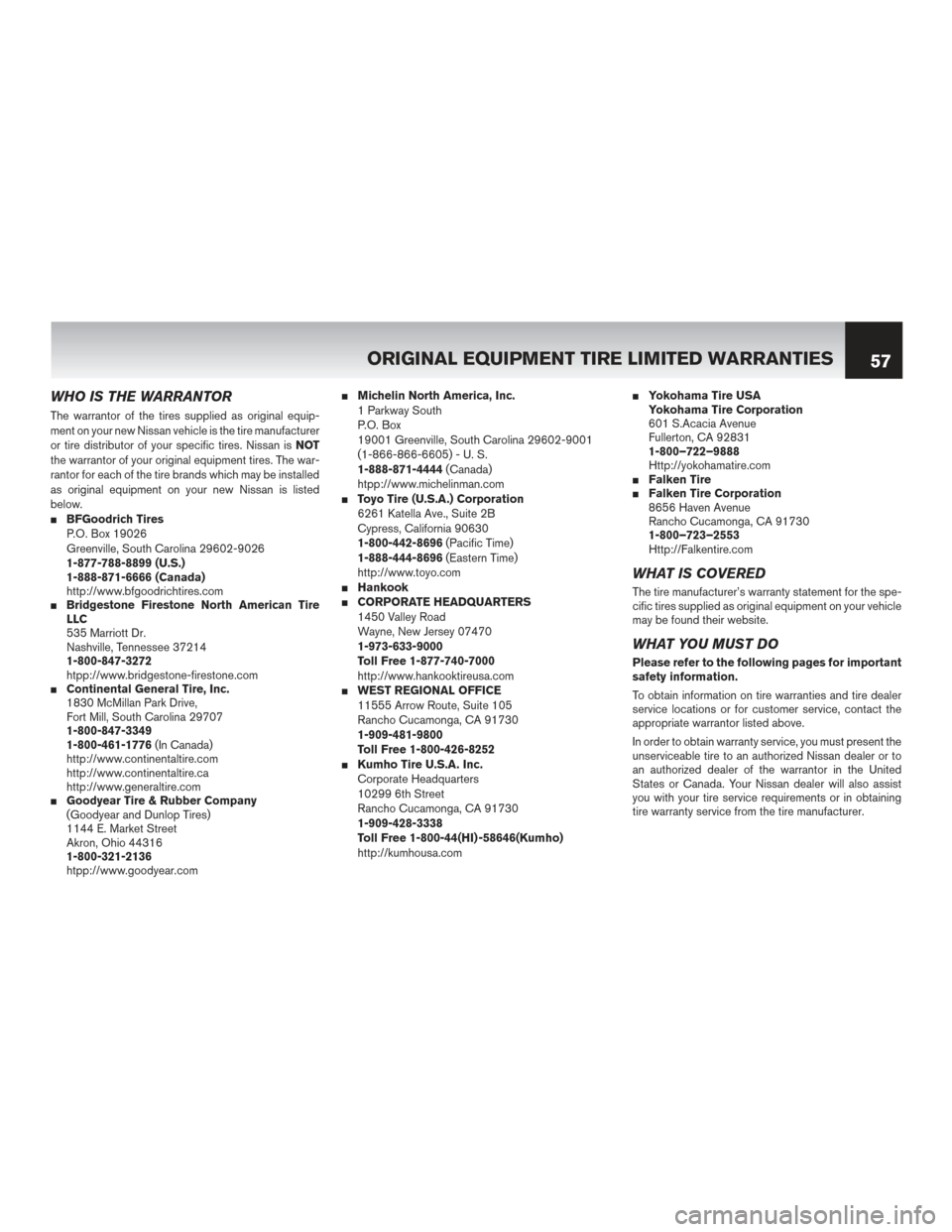
WHO IS THE WARRANTOR
The warrantor of the tires supplied as original equip-
ment on your new Nissan vehicle is the tire manufacturer
or tire distributor of your specific tires. Nissan isNOT
the warrantor of your original equipment tires. The war-
rantor for each of the tire brands which may be installed
as original equipment on your new Nissan is listed
below.
�BFGoodrich Tires
P.O. Box 19026
Greenville, South Carolina 29602-9026
1-877-788-8899 (U.S.)
1-888-871-6666 (Canada)
http://www.bfgoodrichtires.com
�Bridgestone Firestone North American Tire
LLC
535 Marriott Dr.
Nashville, Tennessee 37214
1-800-847-3272
htpp://www.bridgestone-firestone.com
�Continental General Tire, Inc.
1830 McMillan Park Drive,
Fort Mill, South Carolina 29707
1-800-847-3349
1-800-461-1776 (In Canada)
http://www.continentaltire.com
http://www.continentaltire.ca
http://www.generaltire.com
�Goodyear Tire & Rubber Company
(Goodyear and Dunlop Tires)
1144 E. Market Street
Akron, Ohio 44316
1-800-321-2136
htpp://www.goodyear.com
�Michelin North America, Inc.
1 Parkway South
P.O. Box
19001 Greenville, South Carolina 29602-9001
(1-866-866-6605) - U. S.
1-888-871-4444 (Canada)
htpp://www.michelinman.com
�Toyo Tire (U.S.A.) Corporation
6261 Katella Ave., Suite 2B
Cypress, California 90630
1-800-442-8696 (Pacific Time)
1-888-444-8696 (Eastern Time)
http://www.toyo.com
�Hankook�CORPORATE HEADQUARTERS
1450 Valley Road
Wayne, New Jersey 07470
1-973-633-9000
Toll Free 1-877-740-7000
http://www.hankooktireusa.com
�WEST REGIONAL OFFICE
11555 Arrow Route, Suite 105
Rancho Cucamonga, CA 91730
1-909-481-9800
Toll Free 1-800-426-8252
�Kumho Tire U.S.A. Inc.
Corporate Headquarters
10299 6th Street
Rancho Cucamonga, CA 91730
1-909-428-3338
Toll Free 1-800-44(HI) -58646(Kumho)
http://kumhousa.com
�Yokohama Tire USA
Yokohama Tire Corporation
601 S.Acacia Avenue
Fullerton, CA 92831
1-800–722–9888
Http://yokohamatire.com
�Falken Tire�Falken Tire Corporation
8656 Haven Avenue
Rancho Cucamonga, CA 91730
1-800–723–2553
Http://Falkentire.com
WHAT IS COVERED
The tire manufacturer’s warranty statement for the spe-
cific tires supplied as original equipment on your vehicle
may be found their website.
WHAT YOU MUST DO
Please refer to the following pages for important
safety information.
To obtain information on tire warranties and tire dealer
service locations or for customer service, contact the
appropriate warrantor listed above.
In order to obtain warranty service, you must present the
unserviceable tire to an authorized Nissan dealer or to
an authorized dealer of the warrantor in the United
States or Canada. Your Nissan dealer will also assist
you with your tire service requirements or in obtaining
tire warranty service from the tire manufacturer.
ORIGINAL EQUIPMENT TIRE LIMITED WARRANTIES 57
Page 63 of 82
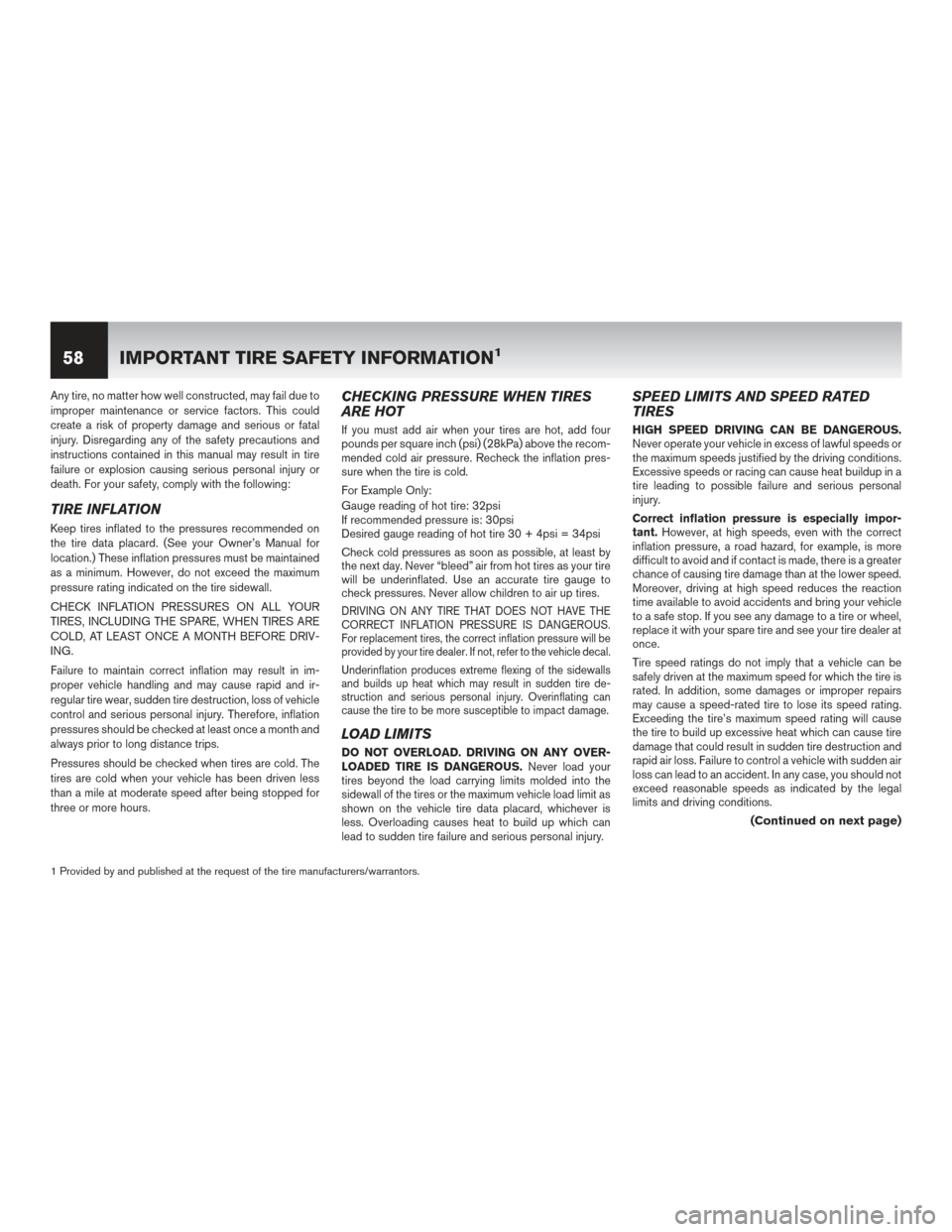
Any tire, no matter how well constructed, may fail due to
improper maintenance or service factors. This could
create a risk of property damage and serious or fatal
injury. Disregarding any of the safety precautions and
instructions contained in this manual may result in tire
failure or explosion causing serious personal injury or
death. For your safety, comply with the following:
TIRE INFLATION
Keep tires inflated to the pressures recommended on
the tire data placard. (See your Owner’s Manual for
location.) These inflation pressures must be maintained
as a minimum. However, do not exceed the maximum
pressure rating indicated on the tire sidewall.
CHECK INFLATION PRESSURES ON ALL YOUR
TIRES, INCLUDING THE SPARE, WHEN TIRES ARE
COLD, AT LEAST ONCE A MONTH BEFORE DRIV-
ING.
Failure to maintain correct inflation may result in im-
proper vehicle handling and may cause rapid and ir-
regular tire wear, sudden tire destruction, loss of vehicle
control and serious personal injury. Therefore, inflation
pressures should be checked at least once a month and
always prior to long distance trips.
Pressures should be checked when tires are cold. The
tires are cold when your vehicle has been driven less
than a mile at moderate speed after being stopped for
three or more hours.
CHECKING PRESSURE WHEN TIRES
ARE HOT
If you must add air when your tires are hot, add four
pounds per square inch (psi) (28kPa) above the recom-
mended cold air pressure. Recheck the inflation pres-
sure when the tire is cold.
For Example Only:
Gauge reading of hot tire: 32psi
If recommended pressure is: 30psi
Desired gauge reading of hot tire 30 + 4psi = 34psi
Check cold pressures as soon as possible, at least by
the next day. Never “bleed” air from hot tires as your tire
will be underinflated. Use an accurate tire gauge to
check pressures. Never allow children to air up tires.
DRIVING ON ANY TIRE THAT DOES NOT HAVE THE
CORRECT INFLATION PRESSURE IS DANGEROUS.
For replacement tires, the correct inflation pressure will be
provided by your tire dealer. If not, refer to the vehicle decal.
Underinflation produces extreme flexing of the sidewalls
and builds up heat which may result in sudden tire de-
struction and serious personal injury. Overinflating can
cause the tire to be more susceptible to impact damage.
LOAD LIMITS
DO NOT OVERLOAD. DRIVING ON ANY OVER-
LOADED TIRE IS DANGEROUS.Never load your
tires beyond the load carrying limits molded into the
sidewall of the tires or the maximum vehicle load limit as
shown on the vehicle tire data placard, whichever is
less. Overloading causes heat to build up which can
lead to sudden tire failure and serious personal injury.
SPEED LIMITS AND SPEED RATED
TIRES
HIGH SPEED DRIVING CAN BE DANGEROUS.
Never operate your vehicle in excess of lawful speeds or
the maximum speeds justified by the driving conditions.
Excessive speeds or racing can cause heat buildup in a
tire leading to possible failure and serious personal
injury.
Correct inflation pressure is especially impor-
tant. However, at high speeds, even with the correct
inflation pressure, a road hazard, for example, is more
difficult to avoid and if contact is made, there is a greater
chance of causing tire damage than at the lower speed.
Moreover, driving at high speed reduces the reaction
time available to avoid accidents and bring your vehicle
to a safe stop. If you see any damage to a tire or wheel,
replace it with your spare tire and see your tire dealer at
once.
Tire speed ratings do not imply that a vehicle can be
safely driven at the maximum speed for which the tire is
rated. In addition, some damages or improper repairs
may cause a speed-rated tire to lose its speed rating.
Exceeding the tire’s maximum speed rating will cause
the tire to build up excessive heat which can cause tire
damage that could result in sudden tire destruction and
rapid air loss. Failure to control a vehicle with sudden air
loss can lead to an accident. In any case, you should not
exceed reasonable speeds as indicated by the legal
limits and driving conditions.
(Continued on next page)
1 Provided by and published at the request of the tire manufacturers/warrantors.
58 IMPORTANT TIRE SAFETY INFORMATION1
Page 64 of 82

SPEED SYMBOLS -are shown on the sidewall of
some tires. The following table shows the maximum
speed corresponding to the symbol.SPEED RATINGS †Speed Speed
Maximum Rating mph km/Hr
M 81 130
N 87 140
P 93 150
R 99 160
R 106 170
S 112 180
T 118 190
H 130 210
W 168 270
Y 186 300
V* 149 240
Z** 149 240
*Some V (or VR) rated tires may have a speed
capacity of greater than 149 mph (240 km/h).
Consult your tire manufacturer for maximum speed rat-
ings if your vehicle capability exceeds this speed.
**Z (or ZR) rated tires are designed for use on
cars with maximum speed capabilities in excess
of 149 mph (240 km/h). Consult your tire manufac-
turer for maximum speed capabilities.
†Although a tire may be speed rated, we do not endorse
the operation of any vehicle in an unsafe or unlawful
manner. Speed ratings are based on laboratory tests which relate to performance on the road, but are not
applicable if tires are underinflated, overloaded, worn
out, damaged, altered, improperly repaired, or re-
treaded. Furthermore, tire speed ratings do not imply
that vehicles can be safely driven at the maximum speed
for which the tire is rated, particularly under adverse
road and weather conditions or if the vehicle has un-
usual characteristics. Most highway passenger tires
that do not have a speed symbol in the sidewall have a
maximum speed rating of 105 mph. Light truck highway
tires that do not have a speed symbol on the sidewall of
the tire have a maximum speed of 87 mph. Some light
truck tires may have higher maximum speeds; consult
your tire dealer. The speed and other ratings of re-
treaded tires are assigned by the retreader and voids
the original manufacturer’s ratings.
IMPORTANT:
In order to maintain the speed capability
of the vehicle, replacement tires must have speed rat-
ings equal to or higher than those fitted as original
equipment (as indicated on the vehicle placard or Own-
er’s Manual) . If tires with lower speed ratings are fitted,
the speed capability of the vehicle will be lowered to the
maximum speed capability of the replacement tire as
indicated on the above table.
Remember...High speed driving can be dangerous and
may be damaging to your tires.
And...When driving at highway speeds, correct inflation
pressure is especially important.
Contact the manufacturer of your tires for their position
and assistance on the repair of speed-rated tires. When
you are replacing tires that have a speed rating, you must replace with tires of the same or higher speed
rating if the speed capability of the vehicle is to be
maintained.
VISUAL INSPECTION
INSPECT YOUR TIRES. DO NOT DRIVE ON A
DAMAGED TIRE OR WHEEL.
Check your tires fre-
quently for scrapes, bulges, separations, cuts, snags,
cracks, penetrations or excessive localized wear from
hard braking. Also check for abnormal tire wear, particu-
larly on the edges of the tire tread which may be caused
by misalignment or underinflation. Impacts can damage
the inner portion of the tire without being visible on the
outside. If damage can be seen on the tires or wheels, or
if you suspect that possible impact damage may have
occurred, replace with spare at once and have your tire
store or dealer inspect your tires immediately. Use of a
damaged tire could result in tire destruction. When
inspecting your tires, including the spare, check your air
pressures. If your pressure check indicates that one of
your tires has lost pressure of two pounds or more, look
for signs of penetrations, valve leakage, or wheel dam-
age that may account for the air loss.
All tires will wear out faster when subjected to high
speeds as well as hard cornering, rapid starts, sudden
stops, frequent driving on roads which are in poor
condition, and off-road use. Roads with holes and rocks
or other objects can damage tires and cause misalign-
ment of your vehicle. When you drive on such roads,
drive on them carefully and slowly, and before driving
again at normal or highway speeds, examine your tires
for any damage, such as cuts, bulges, penetrations,
unusual wear patterns, etc.
(Continued on next page)
IMPORTANT TIRE SAFETY INFORMATION159